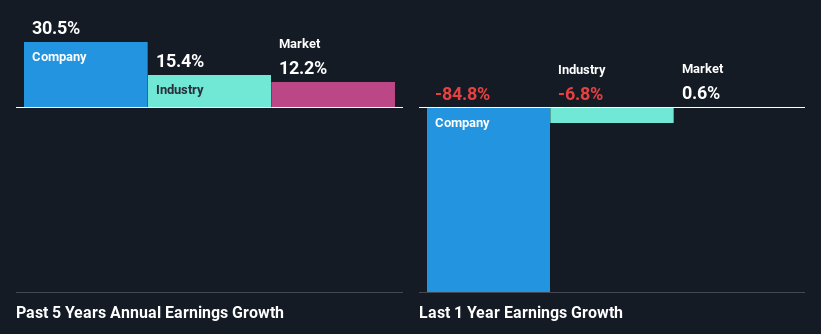Should Weakness in Lords Group Trading plc's (LON:LORD) Stock Be Seen As A Sign That Market Will Correct The Share Price Given Decent Financials?
With its stock down 8.7% over the past three months, it is easy to disregard Lords Group Trading (LON:LORD). However, the company's fundamentals look pretty decent, and long-term financials are usually aligned with future market price movements. Specifically, we decided to study Lords Group Trading's ROE in this article.
Return on Equity or ROE is a test of how effectively a company is growing its value and managing investors’ money. In short, ROE shows the profit each dollar generates with respect to its shareholder investments.
See our latest analysis for Lords Group Trading
How Is ROE Calculated?
The formula for ROE is:
Return on Equity = Net Profit (from continuing operations) ÷ Shareholders' Equity
So, based on the above formula, the ROE for Lords Group Trading is:
3.3% = UK£1.7m ÷ UK£51m (Based on the trailing twelve months to December 2023).
The 'return' is the income the business earned over the last year. That means that for every £1 worth of shareholders' equity, the company generated £0.03 in profit.
What Has ROE Got To Do With Earnings Growth?
Thus far, we have learned that ROE measures how efficiently a company is generating its profits. Based on how much of its profits the company chooses to reinvest or "retain", we are then able to evaluate a company's future ability to generate profits. Assuming everything else remains unchanged, the higher the ROE and profit retention, the higher the growth rate of a company compared to companies that don't necessarily bear these characteristics.
Lords Group Trading's Earnings Growth And 3.3% ROE
It is quite clear that Lords Group Trading's ROE is rather low. Even when compared to the industry average of 13%, the ROE figure is pretty disappointing. In spite of this, Lords Group Trading was able to grow its net income considerably, at a rate of 31% in the last five years. We reckon that there could be other factors at play here. Such as - high earnings retention or an efficient management in place.
As a next step, we compared Lords Group Trading's net income growth with the industry, and pleasingly, we found that the growth seen by the company is higher than the average industry growth of 15%.
The basis for attaching value to a company is, to a great extent, tied to its earnings growth. What investors need to determine next is if the expected earnings growth, or the lack of it, is already built into the share price. By doing so, they will have an idea if the stock is headed into clear blue waters or if swampy waters await. Is Lords Group Trading fairly valued compared to other companies? These 3 valuation measures might help you decide.
Is Lords Group Trading Efficiently Re-investing Its Profits?
Lords Group Trading's three-year median payout ratio is a pretty moderate 40%, meaning the company retains 60% of its income. This suggests that its dividend is well covered, and given the high growth we discussed above, it looks like Lords Group Trading is reinvesting its earnings efficiently.
Moreover, Lords Group Trading is determined to keep sharing its profits with shareholders which we infer from its long history of three years of paying a dividend. Based on the latest analysts' estimates, we found that the company's future payout ratio over the next three years is expected to hold steady at 38%. Regardless, the future ROE for Lords Group Trading is predicted to rise to 11% despite there being not much change expected in its payout ratio.
Conclusion
Overall, we feel that Lords Group Trading certainly does have some positive factors to consider. Despite its low rate of return, the fact that the company reinvests a very high portion of its profits into its business, no doubt contributed to its high earnings growth. On studying current analyst estimates, we found that analysts expect the company to continue its recent growth streak. Are these analysts expectations based on the broad expectations for the industry, or on the company's fundamentals? Click here to be taken to our analyst's forecasts page for the company.
Have feedback on this article? Concerned about the content? Get in touch with us directly. Alternatively, email editorial-team (at) simplywallst.com.
This article by Simply Wall St is general in nature. We provide commentary based on historical data and analyst forecasts only using an unbiased methodology and our articles are not intended to be financial advice. It does not constitute a recommendation to buy or sell any stock, and does not take account of your objectives, or your financial situation. We aim to bring you long-term focused analysis driven by fundamental data. Note that our analysis may not factor in the latest price-sensitive company announcements or qualitative material. Simply Wall St has no position in any stocks mentioned.

 Yahoo Finance
Yahoo Finance 
